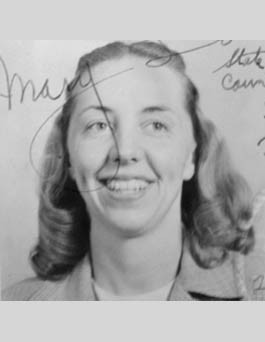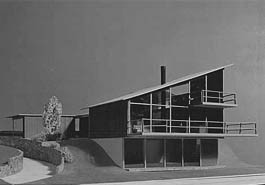
Photo courtesy of Department of Architectural Licensing
Modernism wasn’t delivered like a template in some software package. While it is common and correct to point to Frank Lloyd Wright on a national scale, the Pacific Northwest version of Modernism was developed by a small, loose collection of young architects who were inspired by the opportunity to redefine how we lived and worked. For many reasons, Mary Lund Davis stood out in that select crowd, sometimes in ways that will never occur again. That’s what happens when circumstances and talent help barriers fall.
Mary Lund Davis applied Modernism to buildings that were minimal in size as well as style. She was known for using many of the features we now know as Modern: walls of windows, slightly sloped rooflines, carports that remain open rather than adding a blank box to a building that’s trying to integrate with the environment. Open floor plans removed walls hiding kitchens and cooks, allowing family and guests to more freely mix, and helping some escape that trapped feeling in a cramped room with only appliances and chores for company.

Image courtesy of University of Washington Libraries, Special Collections
The Pacific Northwest’s Japanese and Scandinavian influences were celebrated with a minimalism that made it easier to enjoy and access nature, and calmed interiors by reducing clutter. Those influences were exhibited in her gardens, as well, spaces known for luscious green flowing perennials instead of flamboyant seasonal flower displays.
In touch with the age, Mary Lund Davis incorporated new materials like laminates for counters, kitchens, and cabinetry. It was a natural extension of the family’s connection to the local millwork industry, including a business her husband inherited. Her use of plywood emphasized practicality and efficiency. While many architects concentrated on big buildings and wealthy clients, she developed smaller structures more affordable for a diverse clientele.

Image courtesy of University of Washington Libraries, Special Collections
The design that typified her approach was her own house, an 800-square-foot modular home based on the size of a standard sheet of plywood. The house has the now-classic, then-revolutionary elements of window walls, high ceilings, natural and local materials, and simplicity. The way she incorporated them is a fine example of practicality and affordability. Modular construction was relatively uncommon, but was one way to keep the costs down. Named the “The Fantastic Model Home,” it received the 1966 A.I.A.-Sunset Western Home Award. In 1964 it was estimated to cost $6,000 to build.
One of her designs, a hexagonal Gig Harbor home on Wollochet Bay, was as likely to use 1200-degree corners or triangles rather than squares and more squares. The design ripples throughout the house and onto the landscaping and gardens.

Image courtesy of Wewa Docomomo
Simple ideas like stacking the elements of the house by placing the carport below the living quarters used less land, saved money, eased access, and allowed sightlines through the space to the nature beyond.
Her family ties to local materials and producers meant instead of simply seeing plywood as a flat, 4 x 8 rectangle, she demonstrated its versatility by providing furniture and storage designs for use by do-it-yourself homeowners. Those designs spread her influence far beyond the Pacific Northwest and the homes she designed here.

Image courtesy of University of Washington Libraries, Special Collections
Her training was also uncommon. Mary Lund Davis entered UW in 1942, during World War II. Classrooms had blackout curtains, to defend against anticipated bombers. Her classmates, all men, gradually were called to service, leaving her alone, a class of one. Studying and learning alone removed a support network, but may have enabled freer thinking. In 1946 she became the first female architect in Washington State, an impressive accomplishment that led to an impressive and influential career. Mary Lund Davis passed away in June of 2008 at age 86.